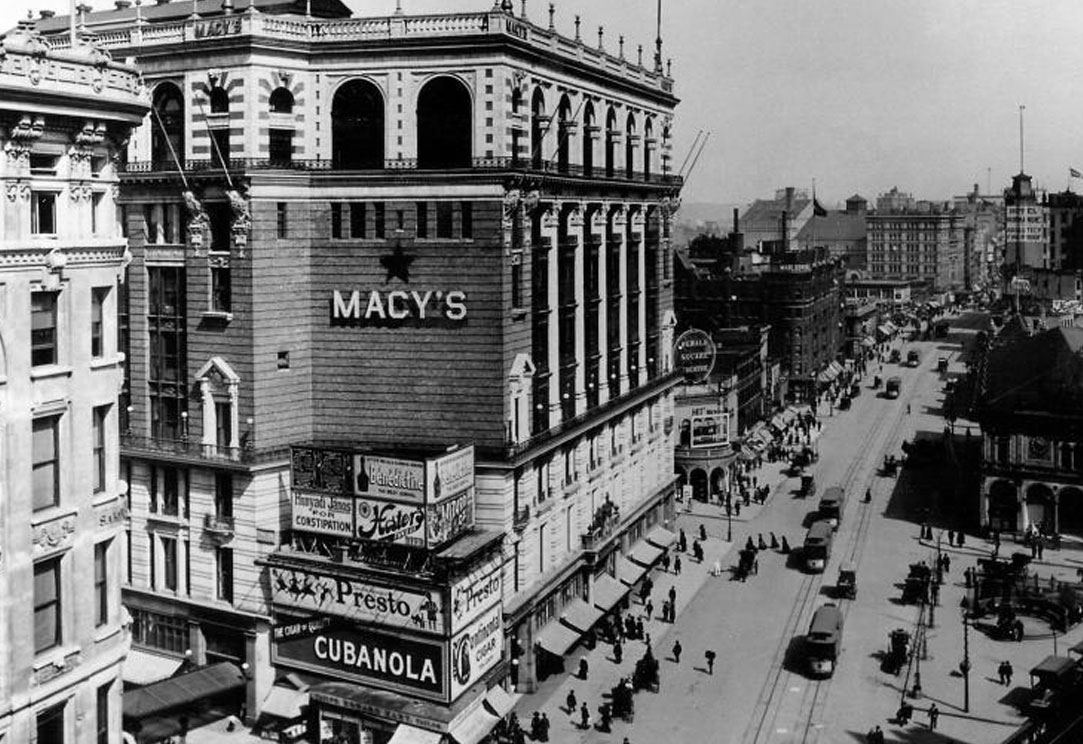After spending four years on a whaling ship, a string of failed dry-goods stores, and a stint in California during the 1849 Gold Rush, Rowland Hussey Macy founded a fancy dry goods store called R.H. Macy & Co. on the corner of 14th Street and 6th Avenue in New York City, then a low-rent district north of the city’s other dry good stores. On its first day, the store earned $11.06 and sales continued to climb, reaching gross returns of around $85,000 in the first year. Over time, Macy expanded his store to occupy 11 adjacent buildings and began selling many different categories of merchandise, effectively creating the first American department store. The original trademark symbol was a rooster, but Macy later changed it to the now-iconic red star, which he based on a tattoo he got on his forearm during his whaling days to represent the star that guided him while at sea. Macy’s success was largely due to innovation. In fact, he’s widely credited with revolutionizing the shopping experience in America. Macy’s was one of the first retailers to offer buying and selling merchandise with cash only. Macy also instituted a one-price system, stated exact prices in newspaper ads, offered money-back guarantees, and introduced several products that at the time were considered new and innovative, including the tea bag, the Idaho baked potato, and colored bath towels. (For a time, the store also offered made-to-measure clothes for men and women that were produced in an on-site factory.) Macy’s also became the first store to feature a Santa Claus during Christmas in 1862, and in 1864, the store began installing illuminated window displays, giving rise to the concept of ‘window shopping’ and the elaborate Christmastime displays that still grace New York City shop windows to this day. In 1866, Macy promoted Margaret Getchell to store superintendent. One of the very first female executives in the business world (although she was asked to give up her salary after her husband joined the company), Getchell played a key role in Macy’s success, using her keen marketing insights and ideas to, as she put it, “astonish the customer” and keep droves of people flocking to the store. According to the Nantucket Historical Society (both Macy and Getchell were island natives), many of the innovations that made Macy’s so successful were her doing — including the decision to feature the Macy’s star on price tags; adding departments for jewelry, home furnishing, and gifts; and developing the store’s now-iconic window displays. Following the death of R.H. Macy, brothers Isidor and Nathan Straus took over ownership of the store. In 1902, the operation moved uptown to Herald Square on 34th St. and Broadway. The 9-story location featured 33 elevators and four wooden escalators — the first to be installed in a store in America. (The original escalators can still be seen today in the Herald Square store.) In 1924, Macy’s employees started the Macy’s Thanksgiving Day Parade, although it was originally called the Macy’s Christmas Parade. The original event featured live animals from the Central Park Zoo and attracted around 10,000 onlookers. That same year, after a store expansion was completed, Macy’s Herald Square became known as “the World’s Largest Store.” The now-famous Macy’s Fireworks Spectacular began in 1976. Over the decades, Macy’s went public, opened stores all over the region, and in 1994, it was acquired by Federated Department Stores, at which point Macy’s became the largest department store retailer in America. In 1997, macys.com was launched. Today, Macy’s has experienced some turbulence but still operates over 400 stores across the United States and is considered a classic, reliable retailer for clothing and many other items.

Your go-to guide for weird history facts
Subscribe to the FREE daily email that makes learning about history fun.


